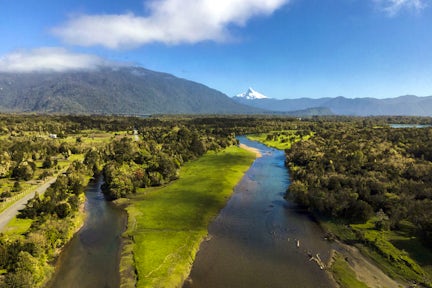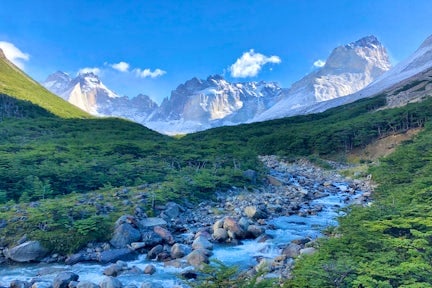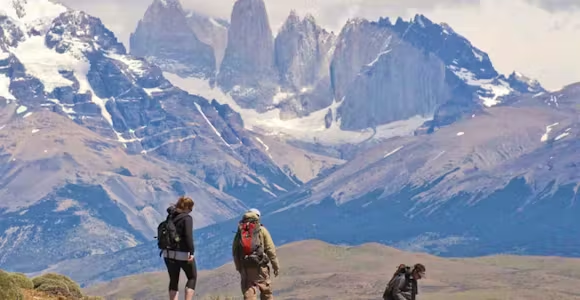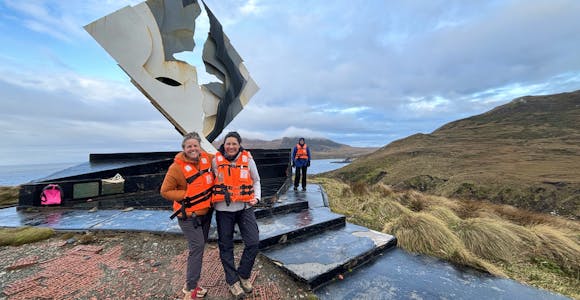
Chilean Lake District
The Chilean Lake District is packed with glacial lakes, snow-capped volcanoes, islands rich in history and folklore, national parks and adventure sports activities.
Discover MoreDeep roots in Patagonia: We are ex-guides, tour leaders, outdoor enthusiasts, & adventurers.
We’ve got our feet on the ground: Impartial advice, a bespoke service, and at no extra cost.
For the ends of the Earth: Sustainability is more than our carbon footprint (but we’re reducing that too).
Deep roots in Patagonia: We are ex-guides, tour leaders, outdoor enthusiasts, & adventurers.
We’ve got our feet on the ground: Impartial advice, a bespoke service, and at no extra cost.
For the ends of the Earth: Sustainability is more than our carbon footprint (but we’re reducing that too).

From the vast lakes of Alerce Andino to the soaring mountains of Torres del Paine, this trail of 17 National Parks in Patagonia is a 1,800-mile stretch of land, water and ice like no other. It was created in 2018 to preserve and support the cultural and geographical heritage of Chilean Patagonia, whilst also boosting economic vitality on a local level.
The Route of the Parks starts at the gateway to both the Andes Mountains and the world famous Patagonian Fjords. From here, you travel south into the region of the Chilean Lakes, where the evergreen forests and elegant waters stretch for miles.
The route then takes you into Aysen, where you can find spectacular fjords, jagged rock walls and magnificent glacier waterfalls. The temperature slowly drops as you travel further south and immense glaciers and snowdrifts begin to appear.
In Magallanes, the Torres del Paine region is home to a range of towering, snow-capped mountains sharply contrasted with turquoise lakes and pristine glaciers. The massif is home to some of the best trekking not only in Patagonia but in the entire world.
Finally, you reach the Tierra del Fuego where you are transported to a landscape of cold desert, tundra that gives way to dense evergreen vegetation and immense unexplored mountain peaks and glaciers. The only point in the world where the waters of the Pacific and Atlantic Oceans meet – you have truly reached the end of the world.
The Chilean Lakes region is mainly made up of numerous accessible protected areas, with the Route of the Parks primarily consisting of two: Pumalín Douglas Tompkins and Alerce Andino, which were founded in 2018 and 1982 respectively. Home to incredible flora, fauna and vast lakes that are surrounded by ice-capped volcanic calderas, Los Lagos has it all, and is the vibrant gateway into wider Patagonia.
Alerce Andino is home to the Alerce tree – with over three thousand years of life this tree is a living, breathing example of how ancient this park truly is.
Over 12,000 years ago, Los Lagos was covered by glaciers but Alerce Andino remained isolated from them, making for a biosphere that can’t be found anywhere else on earth.
The forests are known around the world for their unique fauna – one in three species in Alerce Andino can only be found here.

Alerce Andino National Park
Honropirén is a park of rich and ancient biodiversity that covers over 170,000 acres of the Chilean Lakes region.
The park is part of the World Biosphere Reserve of Temperate Rainforests of the Austral Andes, and in the Pleistocene era there was great glacial activity that shaped this region’s volcanic landscape.
In the Park there are also geomorphological features typical of the Patagonian Pacific Cordilleras, with rivers and fjords modelled by tectonic, volcanic and glacial processes, which have given rise to a landscape of tall, abrupt mountains and narrow, deep valleys.

Hornopirén National Park
Pumalín Douglas Tompkin’s seemingly endless forests stretch all the way to the famous Patagonian fjords, creating for a simply stunning coastline that can only be found in this part of the world.
See the hundreds of waterfalls that rush down from glaciers over towering walls of granite, and take in the Chaitén and Michinmahuida Volcanoes that dominate Pumalín’s skyline.

Pumalín Douglas Tompkins National Park
Although not currently open to the public, Corcovado is rugged and almost completely untouched by human activity.
The Corcovado Volcano towers at over 7,500ft above sea level and many see the park’s diverse flora, fauna and natural features as a microcosm of the entire Route of the Parks.
Corcovado’s boundaries stretch for nearly 1,000,000 acres.

Corcovado National Park
With most of the parks that make up Aysen only opening to the public in the past few years, this stretch of the Route of the Parks is perfect for lovers of pure wilderness and absolute untouched nature.
Aysen is primarily made up of the national parks of Laguna San Rafael, Patagonia and Queulat, all of which are very distinct from each other.
From the arid Patagonian steppe to the mosaic of snowy icefields explored by Charles Darwin, the Aysen region has it all.
During the summer, the coasts of Melimoyu are estimated to be home to 10% of the world’s population of cetaceans. In other words, marine beasts such as blue whales, orcas and humpbacks feed along the shores of this unique national park.
Like Corcovado, not all of Melimoyu’s 258,000 acres are presently open to the general public.
It was once considered to be a possible entry point to the mythical City of the Caesars.

The French Valley, Torres del Paine
First seen in the 18th century by Jesuits searching for the mythical City of the Caesars, Queulat, or ‘Sound of Waterfalls’ in the language of the Chong people, is a lush, wild area of land steeped in the rich history of the many native peoples.
Still served by the Carretera Austral, the evergreen Andean forests and the magnificent waterfalls of Queulat make this park undeniably one of the highlights of the entire route.
Queulat is also home to some of the more challenging trekking routes and is perfect for those wanting to venture completely off the beaten path. A wide variety of species can only be found in this part of Patagonia: the Piche (Dwarf Armadillo) and the Huemul (South Andean Deer) in particular.
Only accessible by sea, Isla Magdalena is one of the few parks on the Route best explored by boat.
It lies near to the vast Guaitecas Archipelago, close to Puerto Cisnes. With 80% of Magdalena’s surface protected by the Chilean government, the island is large yet undisturbed.
The coastal bluffs of Isla Magdalena make it very hospitable to species such as penguins, cormorants and sea lions.

Isla Magadalena National Park
Traversed by what is considered to be one of the most beautiful trekking circuits in Patagonia, Cerro Castillo is a hiker’s dream.
From the vibrant trees of the lenga and ñirre forests to the snow-capped Cerro Castillo peak, all 354,000 acres of the park have something to offer. Species such as the huemul (South Andean deer) and the puma call Cerro Castillo home.
The region was once occupied by the Aonikenks, or Tehuelche people – nomads who travelled through Patagonia on foot.

Getting off the beaten track for some blissful hiking in Cerro Castillo, Aysen
The scenery and landscape transforms drastically as you make your way into Patagonia National Park.
The vast valleys, elegantly sculpted by the Chacabuco River, are covered by grasslands that after years of overgrazing by gaucho's animals are now recovering and play host to the highest levels of biodiversity in the Aysén region.
The tale of Patagonia National Park is one of ecological restoration – an idea that underpins the core values behind the Route of the Parks. Welcome to the Patagonian steppe.
Laguna San Rafael is another sharp contrast on the Route of the Parks, moving from the deserts and steppe of Patagonia National Park to the Antarctic climate and landscape of San Rafael.
This park is virtually untouched and there are essentially no signs of human habitation.
The snowy peaks of San Rafael are largely unconquerable, but finding a path along the rivers and past the glaciers allows for some spectacular views of the earth’s colossal creations.

Laguna San Rafael National Park
As the terrain becomes more mountainous and the temperature drops, the Magallanes region offers travellers of the Route of the Park a plethora of new sights, sounds and experiences. The region is mainly made up of the Bernardo O’Higgins and Torres del Paine national parks.
Bernardo O’Higgins is simply vast – it’s the largest national park in Chile by area, and one of the largest in the world.
Torres del Paine is declared the ‘Eighth Wonder of the World’ by many, and the Paine Massif is perfect for trekking and climbing enthusiasts.
Containing the largest glacier in the southern hemisphere and one of the largest ice expanses on the planet, Bernardo O’Higgins National Park can only be fully explored by boat or kayak.
That does not take away from the experience whatsoever; the park is home to an abundance of activities and sights for adventure-seekers and in a sense, it makes the adventure far more unique.
The park was first occupied by the Kawésqar people who arrived on extremely sturdy boats made from coigüe bark.

Bernado O'Higgins National Park
Torres del Paine National Park is one of a kind; the park is host to colossal towers of rock that sit atop striking turquoise lakes and immense icebergs and waterfalls.
Two trekking circuits that cover the expanse of the park – the W and the O – have been described by many as one of the few ‘must-visit’ trails in the world, and for good reason.
The Paine Massif is one of the most dazzling groups of mountains in the world, and to see these geological pieces of art that formed 12 million years ago is nothing short of a privilege.

Los Cuernos (Horns), Torres del Paine
Kawésqar is one of the largest national parks in the world. It comprises over 6,000,000 acres of cordilleras, glaciers, forests, lakes, valleys, fjords and wetlands.
The park boundaries cover the rocky archipelagos of Magallanes and Última Esperanza and there is almost no human influence in the region making it perfect for those seeking a more rugged and demanding adventure.
The Magallanes rainforest sprawls over the landscape with species such as Coigue de Magallanes, Ciprés de las Guaitecas and Canelo all inhabiting this vast expanse on the Route of the Parks.

Pali Aike is home to a wide variety of avian species that are dotted around the unusual landscape.
Described as having a ‘strange, moon-like beauty’, Pali Aike gives off an essence that doesn't truly belong on this planet.
The horizon stretches out for miles across the expansive, flat and arid Patagonian steppe, with occasional craters from a volcanic eruption that occurred just after the Ice Age. Pali Aike is a place like no other.

Pali Aike National Park
The mission of the Route of the Parks is to preserve and support the cultural and geographical heritage of Chilean Patagonia, whilst also boosting economic vitality on a local level through tourism as a result of this conservation. Also to instil the significance of the route as a ecological lifeline for our planet in the face of climate change and the rapid decline in global biodiversity.
As you approach the Antarctic Circle, the landscapes become other-worldly. The Tierra del Fuego, or ‘Land of Fire’, region consists of the Pali Aike, Alberto de Agostini and Cabo de Hornos national parks.
From volcanic deserts to evergreen forests to majestic fjords and vast, open seas, when you reach the Tierra del Fuego region, you have truly reached the end of the world.
This region is even more rugged and wild than those that came before it and is an explorer’s paradise.
Named after the Salesian priest and mountaineer who explored and photographed the region in the early 20th century, Alberto de Agostini National Park is a UNESCO Biosphere Reserve that is home to a rich variety of flora and fauna.
It's also famous for its immaculate icefields and glaciers that graze Chile’s thin coastline.

Pia Glacier, Alberto de Agostini National Park
The wide channels and fjords of the 370,000-acre Yendegaia National Park show why Yendegaia means ‘deep bay’ in the Yagan language.
Although not currently open to the public, it is one of the most remote yet scenic parks on the entire planet, and Yendegaia’s harsh beauty is home to culpeo foxes and the last sub-Antarctic beech forest.

Yendegaia National Park
The only meeting place of the Pacific and Antarctic oceans, Cabo de Hornos, or Cape Horn National Park, is the last stop on the Route of the Parks and can only be reached by boat.
The park is steeped in history and the legends of hundreds of thousands of sailors that have tried to reach the planet’s southernmost point are closely associated with this special part of the world.
As rugged land meets boundless sea, Cabo de Hornos feels limitless. Few have made it this far – and for good reason. There are no hiking trails and essentially no evidence of human civilisation.

The Cape Horn monument
The famous trails of Torres del Paine and Los Glaciares are well marked and well suited to independent hiking for those with experience. Guides can help you access the more remote and lesser known spots that in many cases are equally dramatic.
Having spoken to over a thousand people who have visited the region, our view is that guides bring so much more than safety and navigation - a richer awareness of the region's wildlife, ecology, history, and cultural identity.
For those on a tight budget, self-guided hikes on the main trails of Torres del Paine and Fitz Roy will be a tremendous experience. Those who are experienced and fiercely independent might do well to mix some guided days with some independent days.
Visit our hiking page for more juicy details on the best hiking in Patagonia.
The main trekking season runs from November to March in most destinations. This is when most of the facilities are open, buses are running and the weather is at its best. If you want to see the spring flowers and more snow on the peaks then November is a beautiful time to go. For the Autumn colours then consider late March and early April. Snow and ice conditions for mountaineering and ice cap expeditions will be best from November to January.
Patagonia is a popular destination, and especially so mid-December to mid-January, so if you want to hike the most famous routes then try to visit outside the busiest period, or consider the more off-the-beaten-track routes at this time of the year.
It is possible to trek all year round? Winter in Patagonia (May - August) offers less daylight and colder temperatures. In the Chilean Lake District and Tierra del Fuego there's a lot of rain however in the south and east of Patagonia there's generally less rain and visibility can be better than the peak of summer.
Head over to our when to visit page for more information.
By leaping on a horse or into a kayak you can get truly off the beaten track.
If you are really intrepid you might consider sailing through the Patagonian Fjords and using the boat to access some fantastic remote hiking.
The only toilets are at the refugios and campsites so you need to be prepared to go for wild toilet stops.
The highest peak in Patagonia is 4058m (13,314ft) high and most of the trails don't go higher than 1,500m (4,920ft) so you don't need to acclimatise when you go hiking in Patagonia.
Typically a guided, fully supported trek (with enough porter support that you just carry your own gear including sleeping bag and sleeping mat or hut accommodation) costs US$300-350 per person per day. Self guided treks will be cheaper and hiking from a luxury hotel will be 2 or 3 times more expensive. There are regional differences in costs so if you find Torres del Paine very expensive then have a look at Tierra del Fuego or Aysen.

The Chilean Lake District is packed with glacial lakes, snow-capped volcanoes, islands rich in history and folklore, national parks and adventure sports activities.
Discover More
Argentina's Los Glaciares is full of jagged granite mountains, electric-blue lakes and sparkling glaciers: perfect for anything from short day hikes to epic wilderness treks.
Discover More
The W Trek is Torres del Paine most famous hiking route, which can be walked in a variety of ways, from a multi-day trek to a series of day hikes.
Discover More
Cape Horn is South America’s final lonely outpost in the ocean. Shrouded in the myth and romance of the sea, it’s accessible only by adventure cruise ship.
Discover MoreThis website uses cookies to ensure you get the best experience on our website. Privacy policy